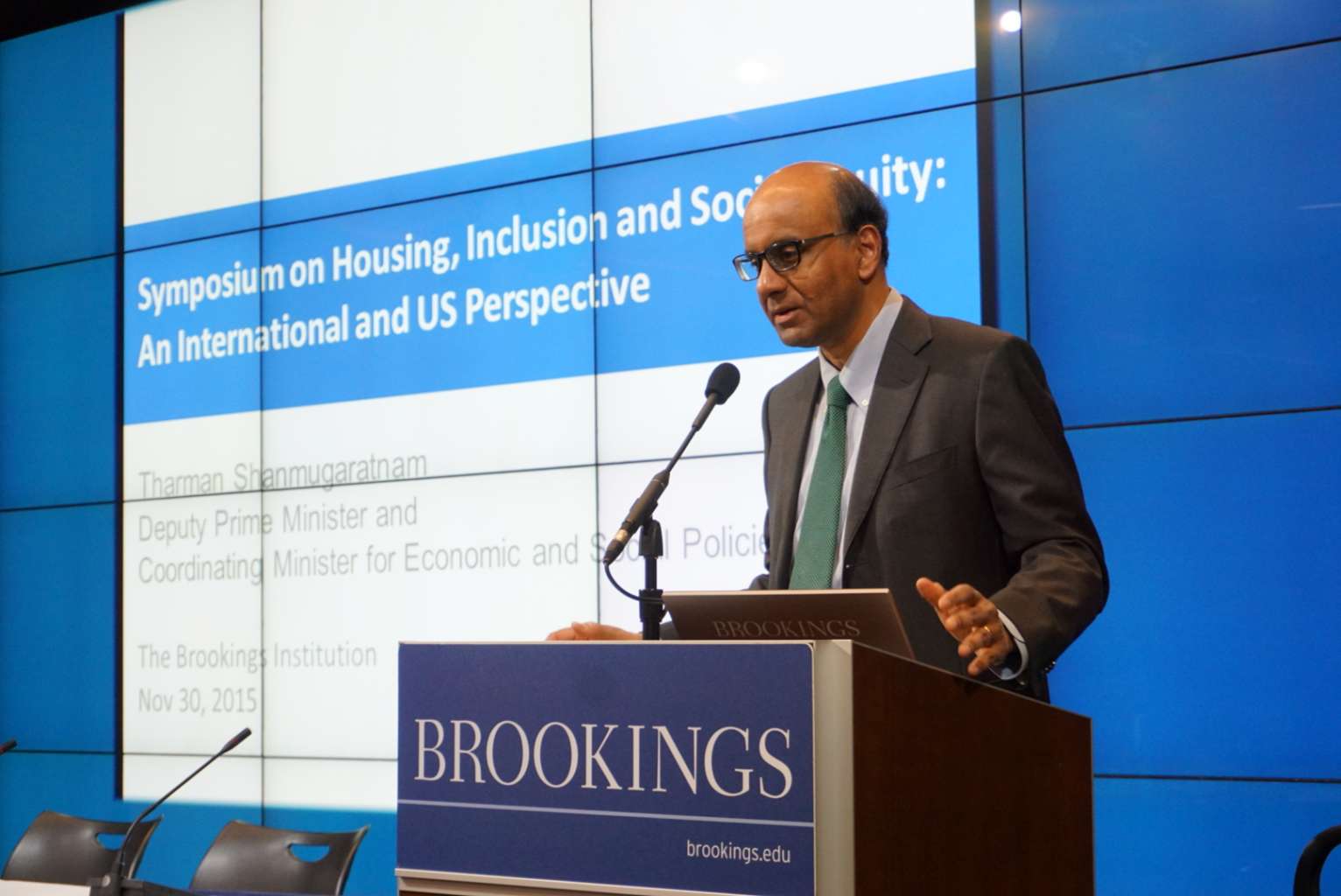Singapore's neighbourhoods key to social inclusion, says DPM Tharman
Sign up now: Get ST's newsletters delivered to your inbox

Singapore’s Deputy Prime Minister Tharman Shanmugaratnam delivering his keynote address at a Brookings Institution conference in Washington.
ST PHOTO: JEREMY AU YONG
Follow topic:
Improving social inclusion and mobility is becoming tougher even as it becomes more important, said Singapore's Deputy Prime Minister Tharman Shanmugaratnam in Washington on Monday (Nov 30), as he outlined for an American audience Singapore's approach to the problem.
And while acknowledging that keeping a multicultural society together requires "continuous work", Mr Tharman said that Singapore's relative success in this area so far can be attributed to one key ingredient: its neighbourhoods.
"The secret sauce is our neighbourhoods, their composition and the way the neighbourhoods are designed so as to maximise interaction and give us the best chance of achieving an integrated society," he said at a Brookings Institution conference centred on the theme "housing, inclusion and social equity".
"It's not just about the numbers - the balance of ethnic groups in different neighbourhoods - it's about the everyday experiences. It's walking the corridors and taking the same elevators as your neighbours every day; it's the way the kids grow up together in the playgrounds and in the primary school nearby; it's about the peers in the neighbourhood. Neighbourhoods matter, the culture of neighbourhoods matter, but it doesn't come about by accident," he said in his keynote address.
Mr Tharman, who is also Coordinating Minister for Economic and Social Policies, was invited to deliver the keynote address at the conference by organisers who said they wanted to gain insight into Singapore's approach to the problem of segregated communities.
Enclaves and segregation in the United States have been a key focus in the country this year, especially after racial incidents and riots in towns like Ferguson and Baltimore were found to have roots in deeply divided neighbourhoods.
The problem of segregation of minorities in cities in Europe has also come under the spotlight against the backdrop of the threat of radicalism in marginalised communities.
In his address, Mr Tharman gave a broad sweep of Singapore's thinking on the subject, outlining, in particular, how so many of the different pieces - housing race quotas, upgrading, education policies and urban planning - all fit together to make Singapore's multicultural society work.
One principle, he said, was that when it came to social interventions, the Singapore government had decided to jump in upstream instead of downstream - even if some consider the measures to be intrusive social engineering.
"You either engage in social interventions or, if you like social engineering, by design, as intelligently as you can, under the best public purposes in mind or you engage in social interventions and engineering by default. And typically, if you do it by default, once problems have accumulated, the problems are larger, they are more intractable and they are more expensive," he said during the dialogue after his speech.
Mr Tharman also said that just as the invisible hand of the market can produce inefficient outcomes, social forces can push society apart.
"Financial markets can also be extremely inefficient even in economic terms, as we know from the global financial crisis. The consensus has shifted and it would be crazy to think we can do without regulating markets. We also know that societies don't naturally trend towards some equilibrium, they don't naturally trend towards harmony, and particularly ethnic and religious accommodation and harmony. It's not a natural tendency of society, it's not part of the natural workings of society that you get people wanting more and more to live with people who are different from them," he said.
"So we need the visible hand of public policy to mitigate the invisible hand of markets, both the economic market as well as the invisible hand of social forces."
H e explained that in Singapore, this intervention cut across many different policies. Besides building small flats next to big ones and setting housing quotas to ensure that racial enclaves do not form, he stressed that it was crucial to have quality public spaces, high standards of service and rejuvenation to ensure estates do not fall into disrepair, and good access to jobs and good schools.
"The policies of integration that I've described... have given society something for free, a bonus. It has given us home equity appreciation for the lower income group, no less than for those in the middle and above. It would not be possible if they were living in an enclave by themselves or a neighbourhood by themselves, which is common in many cities.
"By designing neighbourhoods so they are mixed for all income groups and with high quality shared spaces, attractive for everyone to live in, everyone's home equity goes up," he said.
"We have disadvantaged persons, we have disadvantaged families, we have at-risk youth, but we don't have disadvantaged neighbourhoods in Singapore, and we don't have an at-risk neighbourhood. That's a big difference," he added.

